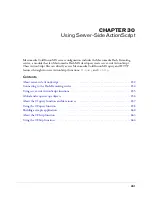
Linking charts to URLs
637
For example, to let users click on the graph to open the page moreinfo.cfm, and pass all three
values to the page, you code the
url
attribute as follows:
url="moreinfo.cfm?Series=$SERIESLABEL$&Item=$ITEMLABEL$&Value=$VALUE$"
The variables are not enclosed in # signs like ordinary ColdFusion variables. They are enclosed in
dollar signs. Clicking on a chart that uses this
url
attribute value could generate a URL in the
following form:
http://localhost:8500/tests/charts/moreinfo.cfm?
Series=Department%20Salaries&Item=Training&Value=86000
You can also use JavaScript in the URL to execute client-side scripts. For an example, see
“Linking
to JavaScript from a pie chart” on page 639
.
Dynamically linking from a pie chart
In the following example, when you click a pie wedge, ColdFusion displays a table that contains
the detailed salary information for the departments represented by the wedge. The example is
divided into two parts: creating the detail page and making the pie chart dynamic.
Part 1: creating the detail page
This page displays salary information for the department you selected when you click on a wedge
of the pie chart. The department name is passed to this page using the
$ITEMLABEL$
variable.
To create the detail page:
1
Create a new application page with the following content:
<cfquery name="GetSalaryDetails" datasource="CompanyInfo">
SELECT Departmt.Dept_Name,
Employee.FirstName,
Employee.LastName,
Employee.StartDate,
Employee.Salary,
Employee.Contract
FROM Departmt, Employee
WHERE Departmt.Dept_Name = '#URL.Item#'
AND Departmt.Dept_ID = Employee.Dept_ID
ORDER BY Employee.LastName, Employee.Firstname
</cfquery>
<html>
<head>
<title>Employee Salary Details</title>
</head>
<body>
<h1><cfoutput>#GetSalaryDetails.Dept_Name[1]# Department
Salary Details</cfoutput></h1>
<table border cellspacing=0 cellpadding=5>
<tr>
<th>Employee Name</th>
<th>StartDate</th>
<th>Salary</th>
<th>Contract?</th>
</tr>
<cfoutput query="GetSalaryDetails" >
<tr>
Summary of Contents for ColdFusion MX
Page 1: ...Developing ColdFusion MX Applications...
Page 22: ...22 Contents...
Page 38: ......
Page 52: ...52 Chapter 2 Elements of CFML...
Page 162: ......
Page 218: ...218 Chapter 10 Writing and Calling User Defined Functions...
Page 250: ...250 Chapter 11 Building and Using ColdFusion Components...
Page 264: ...264 Chapter 12 Building Custom CFXAPI Tags...
Page 266: ......
Page 314: ...314 Chapter 14 Handling Errors...
Page 344: ...344 Chapter 15 Using Persistent Data and Locking...
Page 349: ...About user security 349...
Page 357: ...Security scenarios 357...
Page 370: ...370 Chapter 16 Securing Applications...
Page 388: ...388 Chapter 17 Developing Globalized Applications...
Page 408: ...408 Chapter 18 Debugging and Troubleshooting Applications...
Page 410: ......
Page 426: ...426 Chapter 19 Introduction to Databases and SQL...
Page 476: ...476 Chapter 22 Using Query of Queries...
Page 534: ...534 Chapter 24 Building a Search Interface...
Page 556: ...556 Chapter 25 Using Verity Search Expressions...
Page 558: ......
Page 582: ...582 Chapter 26 Retrieving and Formatting Data...
Page 668: ......
Page 734: ...734 Chapter 32 Using Web Services...
Page 760: ...760 Chapter 33 Integrating J2EE and Java Elements in CFML Applications...
Page 786: ...786 Chapter 34 Integrating COM and CORBA Objects in CFML Applications...
Page 788: ......
















































